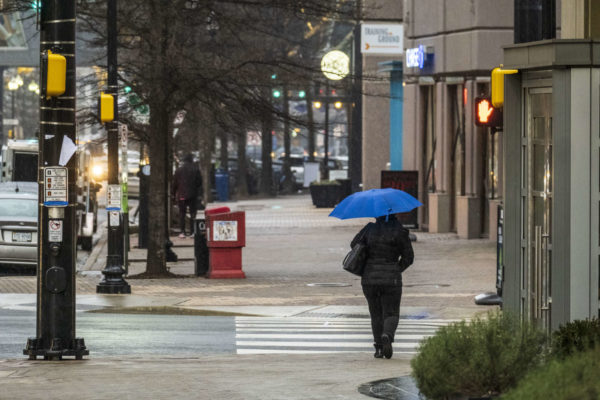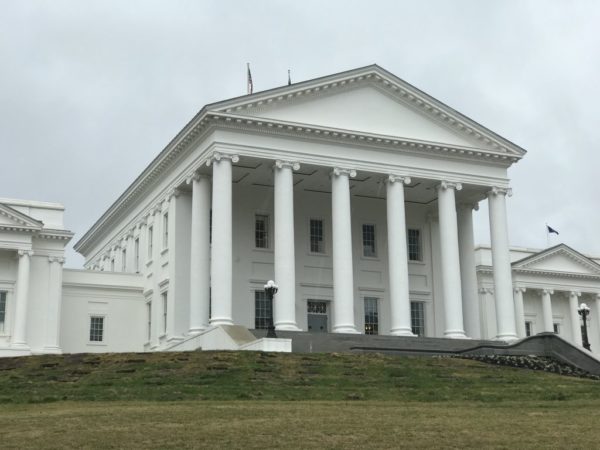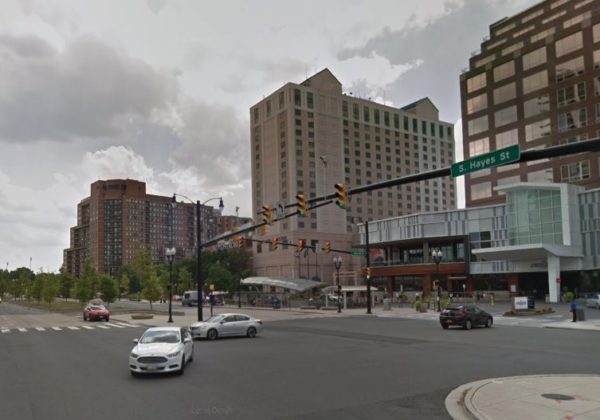Five arterial streets north of Route 50 could see their speed limits drop from 30 to 25 mph.
This weekend, the Arlington County Board is set to authorize public hearings to lower speed limits along these roads, which have “high volumes of pedestrian crossings and higher density land development,” a county report says.
They include:
- Military Road from Nelly Custis Drive to Langston Blvd, through the Donaldson Run and Cherrydale neighborhoods
- N. Carlin Springs Road from N. Glebe Road to N. George Mason Drive, through Arlington Forest
- N. George Mason Drive from N. Carlin Springs Road to Arlington Blvd, through Buckingham
- Fairfax Drive from N. Kirkwood Road to I-66 ramps, through Virginia Square
- 10th Street N. from Washington Blvd to N. Kirkwood Road, near Clarendon
Arlington’s Dept. of Environmental Services recommended 25 mph limits on these roads after looking at “speed statistics, collisions, traffic volumes, current and anticipated pedestrian and bicyclist activity, adjacent land uses and development patterns, future projects and roadway characteristics,” per the report.
Since adopting its Vision Zero policy in 2021, the County Board has taken steps to its goal of eliminating traffic deaths and serious injuries by 2030 in part by lowering speed limits around schools and along several road segments throughout the county.
“The Arlington County Vision Zero policy supports the reduction of drivers’ speed,” it continues. “The Vision Zero Action Plan notes that speeding contributes to about a quarter of both fatal and serious crashes.”
Most of the intersections teed up for lower speeds share two conditions: significant pedestrian and cyclist activity, particularly at uncontrolled crosswalks, and relatively high crash rates, according to the county.
Military Road from Nelly Custis Drive to Langston Blvd has relatively high pedestrian crossings at uncontrolled crossings in the school zone for Dorothy Hamm Middle School. The crash rate in this segment is higher than elsewhere on Military Road, with 14 crashes in six years.
On N. Carlin Springs Road from N. Glebe Road to N. George Mason Drive, there were three pedestrian-involved crashes in six years.
N. George Mason Drive from N. Carlin Springs Road to Arlington Blvd, which carries approximately 22,000 vehicles per day, passes by Barrett Elementary School, the Lubber Run Community Center and medium-density apartment buildings — resulting in a high number of pedestrian and bicycle crossings at uncontrolled crosswalks. This segment includes the crash-prone intersection with N. Park Drive set to get a traffic light later this year.
Although actual driving speeds along Fairfax Drive from N. Kirkwood Road to the I-66 ramps are below the posted 30 mph speed limit, the county still recommends lowering the limit to 25 mph. Of the 162 crashes on this road in six years, 18 involved pedestrians and six caused severe injuries.
The roadway segment of 10th Street N. from Washington Blvd to Kirkwood Road are not part of what the county calls a “High Injury Network” but saw nine pedestrian-involved crashes and three severe-injury crashes in six years. This area is set to receive transportation upgrades also intended to improve safety for road users.
The county reviewed but is not recommending speed limit reductions for the following intersections:
- Nelly Custis Drive from Lorcom Lane to Military Road
- S. Carlin Springs Road from Arlington Blvd to Columbia Pike
- Williamsburg Blvd from N. Glebe Road to 29th Street N.
- N. Roosevelt Street from 17th Street N. to the Falls Church City line
- N. Sycamore Street from Williamsburg Blvd to 17th Street N.
- N. George Mason Drive from Yorktown Blvd to Arlington Blvd
- S. George Mason Drive from Arlington Blvd to the Fairfax County line
- N. Westmoreland Street from Arlington County line to Fairfax Drive
To add new signage will cost about $700 per corridor, for a total of $3,500.
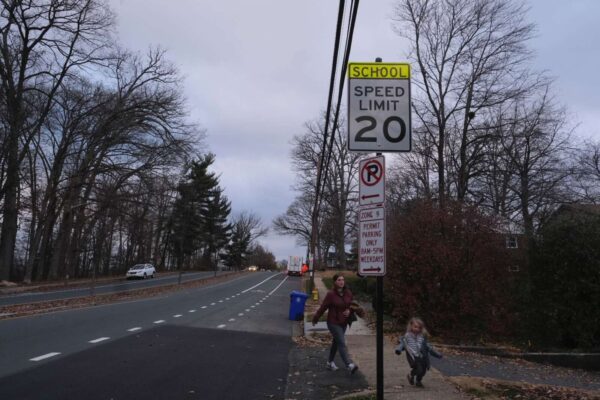
Lower speeds near schools could soon become countywide policy in Arlington.
On Saturday, the Arlington County Board is set to consider an ordinance to lower speed limits to 20 miles per hour on streets within 600 feet of a school property or pedestrian crossing in the vicinity of the school. This would expand on slow zones around 13 schools instituted last year.
The county says in a report that the proposed slow zones respond to positive community feedback from the first round of school zones and are part of its efforts to eliminate traffic-related serious injuries and deaths by 2030, also known as “Vision Zero.”
The ordinance comes as Arlington County appears to have ended 2022 with fewer severe injury crashes than 2021 — when the County Board approved a Vision Zero plan — but the same number of fatal crashes.
In 2022, there were 44 severe and four fatal crashes, including two fatal pedestrian-involved crashes, per county data available through Nov. 23, 2022. The year before, there were 61 severe and four fatal crashes, none of which involved a pedestrian.
If approved, the Dept. of Environmental Services will lower the speed limit on 36 road segments starting next month, according to spokesman Peter Golkin.
“We expect signs to start posting the new speed limit in February-March,” he said. “We will follow up with additional pavement markings in the spring once weather permits.”
When complete, drivers will notice treatments such as high visibility crossings and school zone signage within the school zone, as well as appropriate speed limits on the school’s beaconed arterial roadways, per a December Vision Zero newsletter.
The new, lowered speed limit of 20 mph, applicable at all times of day, will be in effect and enforceable “as soon as the new speed limit signs are posted,” Golkin said.
To remind drivers of the change, the county will send public announcements during February and March through county email lists, civic associations, APS channels and social media, he said, noting that “news coverage like ARLnow’s will also be a great help.”
In addition, he said, the signs themselves will be a notification.
“Drivers should always be cognizant of the speed limit when driving,” the DES spokesman said. “They also have a bright neon yellow SCHOOL symbol on top of them, which should generate extra attention.”
The Arlington County Board last year took another step to reduce speeds, approving the installation of moveable speed cameras in school and work zones. In response to a rash of critical crashes, including a fatal pedestrian fatally struck near Nottingham Elementary School in October, Board members put more pressure on staff to respond more quickly.
Around where the pedestrian was struck on Little Falls Road, Arlington County police issued 10 traffic ticket in one hour during a one-day enforcement effort last month. Also in mid-December, some “quick-build” improvements were installed along the road, between John Marshall Drive & N. Kensington Street, per the December Vision Zero newsletter, below.
The improvements at John Marshall Drive include:
- Addition of a high visibility crosswalk on the south crosswalk
- Tactical curb extensions to sharpen/slow down turning vehicle turns and reduce crossing distances
- Additional signage
Improvements at N. Lexington Street include:
- Bus stop/sharrow markings
- High visibility crosswalks
- A tactical curb extension to sharpen/slow down turning vehicle turns and reduce crossing distances.
Improvements at N. Kensington Street (north side) include:
- High visibility crosswalks
- Tactical curb extensions to sharpen/slow down turning vehicle turns and reduce crossing distances
- Enhanced signage at the crossing over Little Falls Road
- Changing the yield to a stop sign (south side)
These improvements are currently in progress and will ultimately encourage slower vehicle speeds, and improved pedestrian and transit maneuvers.
Additionally, DES is conducting an all-way stop evaluation and is collecting footage of the Little Falls Rd and John Marshall Dr intersection to monitor operations between all road users. These evaluations will be considered as DES plans for permanent intersection improvements.
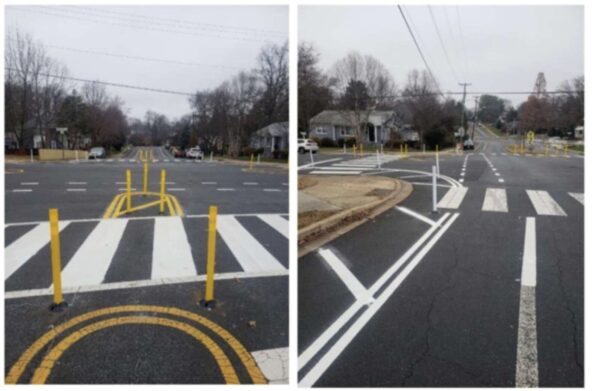

Arlington is proposing to lower speed limits near schools across the county to 20 mph as the county’s second year of Vision Zero enters the rear-view mirror.
This Saturday, the Arlington County Board is set to hear a proposal to expand these slow zones to all schools, after many people said they felt safer walking, biking and driving in 13 school zones where the speed limit has already dropped to 20 mph.
If the Board approves the changes, school zones will all get permanent signs with the new speed limits. The county says this is cheaper and more broadly applicable than flashing beacons, which will only be used on arterial streets within 600 feet of schools during arrival and dismissal times.
This change follows the approval earlier this year of moveable speed cameras to be installed in school and work zones, as well as calls from the Arlington County Board for a quicker staff response to critical crashes, after a driver fatally struck a pedestrian in an intersection near Nottingham Elementary School.
Schools have figured into other notable crashes, including a fatal crash involving a motorcyclist and a school bus in front of Drew Elementary in 2021 and a crash involving a drunk driver who killed a pedestrian near Thomas Jefferson Middle School this summer. In a less serious crash this fall, a driver struck an adolescent cyclist near Kenmore Middle School.
Lowering speeds is one action the county has taken over the last year and a half to work toward its goal of eliminating traffic-related fatalities and serious injuries by 2030, a plan known as Vision Zero.
“There are no corridors on county-owned roads that have a speed limit higher than 30 miles per hour, which is a big improvement. We’re very excited to say that,” Arlington Vision Zero coordinator Christine Sherman Baker said in a meeting last week.
In addition to lower speeds, the county has set up temporary school walking routes and roundabouts, completed 13 quick-build projects and made improvements to six critical crash sites and 14 crash “hot spots.” Staff are working on procuring speed cameras for school and work zones and red light cameras for six more intersections, which could be installed in 2023.
Amid the flurry of work, preliminary data from the first nine months of 2022 indicate crashes are down overall, according to a Vision Zero report released last month. As of Aug. 30, there were 1,313 crashes in Arlington, of which two were fatal and 34 were severe. (We’ve since reported on two additional fatal crashes.)
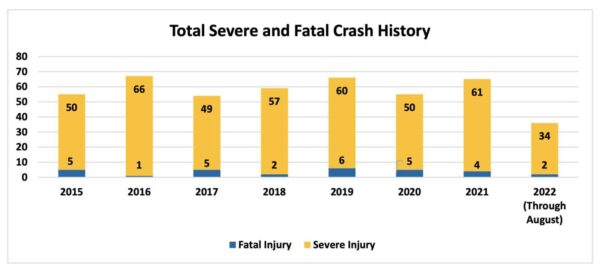
Pedestrian-involved crashes and crashes in intersections are both slightly lower, while bike crash figures are consistent with previous years. There has yet to be a crash in a work zone.
“Alcohol and speed prove to be some of our biggest challenges on our roadways,” Baker said in the meeting.
But some people say the county needs to be clearer in communicating if and how its work is reducing crashes as well as the dangers of driving.
(Updated at 4:30 p.m.) A handful of main roads in Arlington may be getting speed limit reductions.
At its meeting this Saturday, the Arlington County Board is slated to vote to advertise a potential reduction in the speed limit on four arterial streets, per a staff report.
The reductions would target road segments with high volumes of pedestrians walking to and from transit stations, schools, apartment buildings and commercial areas, the county says. Among them:
- Washington Blvd from Arlington Blvd (Route 50) to N. Pershing Drive (35 to 30 mph)
- S. Joyce Street from Columbia Pike to Army Navy Drive (35 to 30 mph)
- Columbia Pike from S. Dinwiddie Street to the Fairfax County line (35 to 30 mph)
- Lorcom Lane from Cherry Hill Road to Military Road (30 to 25 mph)
The segments also have more serious and fatal crashes than other roads, the report said.
The selected segment of Washington Blvd, south of Clarendon, sees lots of foot traffic due to the public transit stops on both sides of the road connected by controlled and uncontrolled marked crosswalks, according to the county.
The corridor had 39 crashes in a 5-year period, and is one of the roads in Arlington’s Vision Zero High Injury Network, which accounts for 78% of all serious or fatal crashes. North of Arlington Blvd, the speed limit on Washington Blvd is already 30 mph.
S. Joyce Street, in the Pentagon City area, also has “steady” pedestrian activity due to a transit stop. The county says more people will walk, cycle and scoot along the road — which passes near the Air Force Memorial — once Columbia Pike is realigned to expand Arlington National Cemetery.
Lower speeds here “are essential” for lowering the risk of severe collisions, since the lane widths are limited and have no shoulders, per the report. To improve walkability on this stretch of S. Joyce, the county widened sidewalks and installed new lighting in 2013.
The Dept. of Environmental Services also recommends lowering speeds on the segment of Columbia Pike from S. Dinwiddie Street to the Fairfax County line to account for increased walking and transit use associated with new transit stations. Columbia Pike, with 85 crashes in a five-year period, of which six involved pedestrians, is also part of what has been designated the “High Injury Network.”
Continuing east on Columbia Pike, the speed limit is currently 30 mph.
Meanwhile, a high volume of people walk and cycle across Lorcom Lane to go to and from Dorothy Hamm Middle School, per the report. The school also has foot traffic outside school hours and on weekends, for events such as the Cherrydale Farmers Market, which started last year, despite complaints from some neighbors.
This road saw 18 crashes in six years, and of those, speeding contributed to three crashes.
The county considered, but decided not to lower speeds on segments of S. Walter Reed Drive, S. Four Mile Run Drive and Wilson Blvd from N. Glebe Road to the Fairfax County line — where the limit is currently 30 mph.
At its upcoming meeting, the Board is also expected to enact some speed reductions in Courthouse and Glencarlyn, which were advertised last month. The planned speed limit changes are:
- Fairfax Drive from Arlington Boulevard to N. Barton Street (30 mph to 25 mph)
- 5th Road S. from S. Carlin Springs Road to the Fairfax County line (35 mph to 25 mph)
A pair of local road segments are set for a speed limit reduction.
At its meeting this coming Saturday, the Arlington County Board is expected to vote to advertise changes in the speed limit along Fairfax Drive from Arlington Boulevard to N. Barton Street, near Courthouse and Rocky Run Park, and on 5th Road S. from South Carlin Springs Road to the Fairfax County line, near Carlin Springs Elementary School.
“The Department of Environmental Services, Division of Transportation has conducted a study on each of the above-mentioned corridors,” a report to the County Board says. “The results of the studies recommend that the speed limit be decreased from 30 miles per hour (mph) to 25 mph on the studied segment of Fairfax Drive and from 35 mph to 25 mph on the studied segment of 5th Road South.”
The ultimate goal is safety.
“One of the implementation actions for that policy is the adoption of lower speed limits for arterial streets on which there are high volumes of pedestrian crossings and higher density land development,” said the report.
The changes will advertised, ahead of a final Board vote on the change set for September. The price tag for the speed limit changes is about a thousand dollars.
“Public notices advertising the County Board’s consideration of this item at its September 17, 2022, meeting will be published in the June 23 and June 30 editions of the Washington Times newspaper,” said the Board report. “The cost of purchasing and installing speed limit signs to reflect these changes will be approximately $500 per corridor, for a total of $1,000.”
More on why the speed limits are being changed, per the report:
The Department of Environmental Services, Division of Transportation has conducted engineering studies on the aforementioned corridors. These studies compiled data on speed statistics, collisions, traffic volumes, current and anticipated pedestrian and bicyclist activity, adjacent land uses and development patterns, future projects, and roadway characteristics. The data were evaluated to determine if the existing speed limits are appropriate, or if a modification to the speed limit is recommended to improve safety. These engineering studies formed the basis of staff’s recommendation to amend the code to lower the speed limits along each of the corridors.
Fairfax Drive from Arlington Boulevard to North Barton Street is classified as a neighborhood roadway and its adjacent land uses are medium to high density residential homes and the popular Rocky Run Park. The street has high pedestrian activity, including a weekday average of over 400 pedestrian crossings per day. The design of the roadway encourages a lower speed limit, supported by the collected data showing 85th percentile speeds just above 25 mph and average speeds just above 20 mph. For these reasons, it is recommended to lower the speed limit from the existing 30 mph limit to 25 mph.
5th Road South between South Carlin Springs Road and the Fairfax County line is a minor arterial roadway that fronts Carlin Springs Elementary School and low-density residential homes. The entirety of the segment is within a school zone, as well as within the walking zone for Carlin Springs Elementary School and Kenmore Middle School. The roadway also includes a buffered bike lane to encourage biking. It is recommended to lower the speed limit from the existing 35 mph limit to 25 mph in order to create a safer environment for all roadway users.
Following an appropriate Board approval, new speed limit signs will be placed in accordance with the Manual on Uniform Traffic Control Devices (MUTCD).
Photos via Google Maps
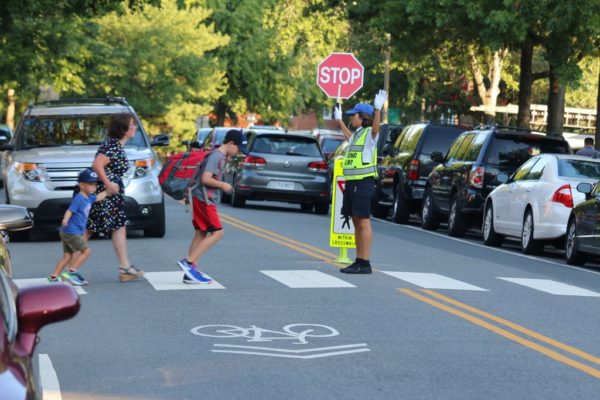
The speed limit is being lowered in some local roads.
The Arlington County Board voted 5-0 on Saturday to approve the establishment of “School Slow Zones,” with 20 mph speed limits. Implementation, around 13 public and private schools, is expected to be complete this later winter or in the spring.
County staff will evaluate the effectiveness of the initial slow zones before moving forward with potentially implementing the lower speed limits around all Arlington schools.
More from an Arlington County press release:
Today, the Arlington County Board voted 5 to 0 to approve the creation of “School Slow Zones,” which aims to reduce traffic speeds around 13 schools across the County. The zones address a key action item in the Vision Zero Action Plan, adopted by the Board in May, and are the first application of permanent 20-mile-per-hour speed limits permitted under Virginia law.
Schools are a key focus area for Vision Zero in Arlington – a nationally recognized strategy to eliminate all fatalities and severe injuries no matter the means of travel, while increasing safety and mobility. Some specific data points:
- One in four crashes in Arlington involves speeding.
- Every year, there are 10+ crashes involving speeding around schools in Arlington.
- The risk of injuries and deaths increases as vehicle speeds increase.
- Children are among the most vulnerable travelers.
The School Slow Zones are the result of an interdepartmental partnership between the Arlington Department of Environmental Services’ Transportation Division, Arlington Public Schools (APS) and the Arlington County Police Department.
“The recent tragic traffic fatalities in our community remind us how important it is to achieve our Vision Zero goal of eliminating serious traffic injuries and deaths,” said Arlington County Board Chair Matt de Ferranti. “These zones are one of many steps the County is taking to help road users reduce speed and increase awareness of people – usually children — walking and biking near our schools.”
What are School Slow Zones?
A School Slow Zone is a permanent 20 mile-per-hour speed limit on a neighborhood street within 600 feet of an access point to a school. Speed limit signs and pavement markings clearly define the zone.
Where will the First Slow Zones Be Located?
This demonstration project approved by the Board will install 11 School Slow Zones around 13 public and private schools in the County (two zones both include pairs of schools very near to each other), to test the effectiveness of the treatments developed by transportation staff. County and APS staff identified schools for the demonstration project from three different sources:
- Through Vision Zero
- Hoffman-Boston Elementary School
- Gunston Middle School
- Drew Elementary School
- In coordination with APS
- Escuela Key Elementary School (formerly Arlington Traditional School)
- Arlington Traditional School (formerly McKinley Elementary School)
- Innovation ES (formerly Key Elementary School
- Cardinal ES (new school)
- Because existing safety beacons suitable for a School Slow Zone need immediate replacement
- Tuckahoe Elementary and nearby Bishop O’Connell High School
- Glebe Elementary School
- Wakefield High School and nearby Claremont Elementary School
- St. Thomas More Cathedral School
Implementing School Slow Zones
Implementation of the first Slow Zones is expected to take between three and five months.
During the demonstration stage, transportation staff will collect “before” and “after” vehicle speed data to assess whether zones, as designed, successfully reduce speeds around schools. Transportation staff will also collect public feedback before considering adjustments to zone infrastructure and placement for all remaining schools in Arlington.
Moving forward, the County anticipates adding ten Slow Zones each year, meaning that the 40-plus public and private schools in the County could be updated within the next three to five years.

(Updated at 9:35 p.m.) Arlington County is looking to lower speed limits near schools as part of its ambitious Vision Zero initiative to eliminate serious traffic-related injuries and deaths by 2030.
This Saturday, the County Board is set to decide whether to authorize a public hearing next month to discuss and potentially approve creating “slow zones” on residential streets near 13 schools.
The proposed 58 zones, with a speed limit of 20 mph, will be near 11 Arlington public schools and well as Bishop O’Connell High School and St. Thomas More Cathedral School.
“Attempts to reduce or eliminate fatal and critical crashes can be achieved by regulating unsafe speeds on our streets with measures such as signage and pavement markings,” a county report said. “Lowering the speed limit can be a basic and powerful tool for reducing vehicle speeds.”
Traditionally, Arlington has installed flashing beacons to encourage drivers to adhere to reduced speed limits near schools. The report said these signs are inconsistently installed and are costly to maintain, while “static signage” and pavement markings, reminding drivers the speed limit is always 20 mph, are cheaper and easier to install.
The signage and markings will be tested out at these 13 sites before they’re installed across Arlington.
“Slower speeds around schools is a no-brainer, and are beneficial for everyone,” Vision Zero program manager Christine Sherman Baker told the Transportation Commission earlier this month. “We want to prioritize safety in school zones because children are still learning how to travel safely: how to cross the street, how to ride a bike. They’re some of our most vulnerable users.”
And they’re learning these skills in risky areas: according to the report, 10 or more speeding-related crashes annually happen within 600 feet of a school in Arlington.
Some schools were chosen because they’re new or have existing infrastructure in need of upgrades, she said. Hoffman-Boston Elementary, Drew Elementary and Gunston Middle schools were chosen because they’re near high-injury networks — and including them would help meet Vision Zero’s equity component.
This fall, Arlington County Police Department has been collecting speeding data that will be compared with new data collected next spring to see if these zones are effective, she said.
The community can provide feedback in March and April of next year, ahead of the county-wide roll out, she added.
The proposal was met with enthusiasm from Transportation Commission members and some members of the public.
“Bravo,” Transportation Commission Chair Chris Slatt said. “I think it’s fantastic.”
Representing local advocacy group Arlington Families for Safe Streets, Gillian Burgess voiced her support for the program during the meeting.
“Slower speeds around schools are not only great for the safety of vulnerable road users, but it also encourages activity, which addresses both child health and health equity,” she said. “It improves air quality and noise pollution around schools… and it promotes mental health and social inclusion.”
ACPD should also “commit publicly” to enforcing speeding near schools, preferably via speed cameras and not just for speeds 10 mph or more above the limit, while the county should consider closing streets in front of schools to cars, Burgess added.
Arlington County is considering lowering the speed limit along a number of corridors with lots of pedestrian activity.
On Saturday, the County Board will decide whether to authorize a public hearing next month to discuss and potentially approve the reductions, which would impact seven corridors throughout Arlington.
The proposals were generated from traffic studies conducted at the request of some citizens, staff and Arlington County Public Schools, according to a report. These studies looked at speeding and crash statistics as well as anticipated pedestrian and bicyclist activity and future projects, among other considerations.
Overall, the studies concluded that lower speed limits would help the county reach its new goal of zero transportation-related deaths and serious injuries by 2030, also known as Vision Zero. Two reductions along Army Navy Drive would also prepare drivers for an upcoming construction project that would rebuild the road to be more pedestrian- and bicycle-friendly, the report said.
“As part of the Streets Element of the Master Transportation Plan, a policy was established to design streets to generally favor lower vehicle speeds without impeding or diverting existing vehicle volumes,” the document said. “One of the implementation actions for that policy is the adoption of lower speed limits for arterial streets on which there are high volumes of pedestrian crossings and higher density land development.”
The studies recommend lowering the speed limit along Army Navy Drive from S. Joyce Street to 12th Street S. from 35 to 25 miles per hour.
Speed limits on six other road segments would be lowered from 30 to 25 miles per hour:
- Army Navy Drive from 25th Street S. to S. Joyce Street
- N. Kirkwood Road from Lee Highway to Washington Blvd
- Yorktown Blvd/Little Falls Road from 26th Street N. to Williamsburg Blvd
- S. Eads Street from S. Glebe Road to 24th Street S.
- S. Eads Street from Army Navy Drive to 15th Street S.
- 15th Street S. from S. Hayes Street to Richmond Highway (Route 1)
The project to rebuild Army Navy Drive as a “Complete Street” is in its final design and review phases, according to the county. During construction, the county is recommending a reduced speed along Army Navy Drive of 25 miles per hour. Making the change now would get drivers accustomed to the change, the document said.
“Significant roadway enhancements are included in this project, so to decrease the speed at the onset of construction would provide for a safer work zone for workers and roadway users and support the expectation of lower speeds once the project is completed,” the report said.
The Army Navy Drive project is intended to improve local connections between the Pentagon and the surrounding commercial, residential and retail services by reducing the number of lanes and their width, enhancing pedestrian and cycling activity, and improving transit facilities.
The studies also found that along all seven corridors, “the majority of motorists are comfortable driving within 5 mph of the existing posted speed limit and the proposed decreased speed limit of 25 mph.” Lower speed limits can help accommodate new development and more robust transit infrastructure in the future, the studies suggest.
These changes would cost about $1,500 per corridor to purchase and install new speed limit signs, for a total of $10,500.
Tornado Drill Today — “Virginia’s annual Statewide Tornado Drill will occur on Tues., March 16 at 9:45 a.m. If widespread severe weather threatens the Commonwealth on that date, the drill will be rescheduled for Wed., March 17, at 9:45 a.m. The Statewide Tornado Drill is an opportunity to prepare Virginians for tornado threats and to test public warning systems.” [Va. Dept. of Emergency Management]
Pentagon Row Harris Teeter’s Future in Flux — “Despite concerns from nearby residents, Arlington County Board members on March 20 could give the owner of Pentagon Row the ability to, potentially, significantly downsize grocery-store operations… Located on a 15-acre parcel in Pentagon City, the site has long included a Harris-Teeter supermarket. But that initial lease term is expiring, and there is no guarantee the supermarket chain will want to stay in the existing space.” [Sun Gazette]
Coronavirus Tests Available at DCA — “Coronavirus testing launched Monday at Reagan National and Washington Dulles International airports, which became the latest airports across the country to offer the tests. The centers are outside the security checkpoints at both airports and are operated by XpresCheck, which runs centers at a number of U.S. airports.” [Washington Post]
New Building to Have Temporary Hotel Rooms — “Arlington County Board members next month are expected to allow another developer to temporarily convert apartment space to hotel use. The developer of the 809-unit property at 1555 Wilson Blvd. is asking permission to use 100 of the residential units as hotel space starting in late summer. Eventually, the units would revert to their originally intended purpose.” [Sun Gazette]
Cherry Blossom Sculptures Arrive in Arlington — From the National Landing BID: “Two official @CherryBlossFest sculptures have landed! One at the Esplanade at Long Bridge Park and one at the Crystal City Water Park. They will be up through May 31.” [Twitter]
Bill Would Allow 15 MPH Speed Limits in Va. — “Currently, any city or county looking to slow traffic in a busy shopping district or on a quiet residential street can go no lower than 25 mph. A bill passed during this year’s General Assembly session, however, would change that, permitting posted speed limits to drop as low as 15 mph. A ten miles per hour difference may not seem huge, but for pedestrian safety advocates and the families of victims of traffic collisions, the change could mean the difference between life and death.” [Greater Greater Washington]
Arlington wants to deploys speed cameras and to lower speed limits in residential and business districts below 25 miles per hour.
Those are among a list of state legislative priorities the Arlington County Board unanimously approved on Saturday before the upcoming session of the Virginia General Assembly in Richmond.
Board member Christian Dorsey said at Saturday’s meeting that speed cameras allow for equitable law enforcement while reducing public interaction with the police.
“We want to reduce the amount of times that potential conflicts can turn into something that’s unintended,” Dorsey said.
“Automated ticket enforcement has the potential to improve safety… and further advance equitable outcomes by reducing or eliminating race-based disparities in speed enforcement,” the county said its legislative priority list.
Board Chair Libby Garvey said Arlington also needs discretion on reducing the speed limit in residential and business areas.
“There’s just so much in this state that we find we have responsibility for things and we don’t have the authority to actually do what we need to do sometimes, so this is just a never-ending stream of things that we’re trying to correct and get control over that we ought to have control over,” Garvey said.
Pat Carroll, Arlington’s liaison to Richmond, told the Board that recent leadership changes within the legislature “noticeably helped the fate of Arlington’s legislative priorities.”
Other approved priorities include:
- “More state funding for localities to respond to the COVID-19 pandemic”
- “Seeking full funding for K-12 education, including ensuring state funding for Arlington Public Schools reflects pre-pandemic levels”
- “Protecting existing Northern Virginia Transportation authority revenues”
- “Allowing individual retail customers to buy 100 percent renewable electricity from any licensed competitive supplier of electric energy”
- “Supporting legislation to provide greater incentives for tree canopy preservation and planting”
- “Enacting authority for a local option to develop incentives or regulations to decrease or regulate the distribution and sale of polystyrene food-service containers”
- “Permit localities and public bodies to set their own rules regarding ‘virtual’ [meeting] participation“
Arlington’s full list of legislative priorities is below the jump.
Drivers along a busy stretch of road in Pentagon City could soon need to slow down a bit.
County officials are proposing changing the speed limit along S. Hayes Street as the road runs between Army Navy Drive and 15th Street S. It currently has posted speed limits of 35 and 30 miles per hour along different stretches of the road, but the county could bump that down to 25 miles per hour.
The Crystal City Business Improvement District requested a study of the speed limit along that section of the street, which runs past major developments, including the Fashion Centre at Pentagon City and Pentagon Centre, as well as the neighborhood’s Metro station.
Staff wrote in a report for the County Board that the “high volumes of pedestrian crossings and higher density land development” in the area justify bumping down the speed a bit.
Similarly, staff noted that an examination of the last four years worth of crash data for the area suggest that a lower speed might be beneficial for the area.
If the Board approves the change, the county will spend $1,500 to install signs advertising the newly revised speed limit along the road.
The Board is set to consider the issue for the first time at its meeting Saturday (March 16), where members are scheduled to set a public hearing on the matter for April 23. The Board could then approve the change immediately afterward.
Photo via Google Maps


